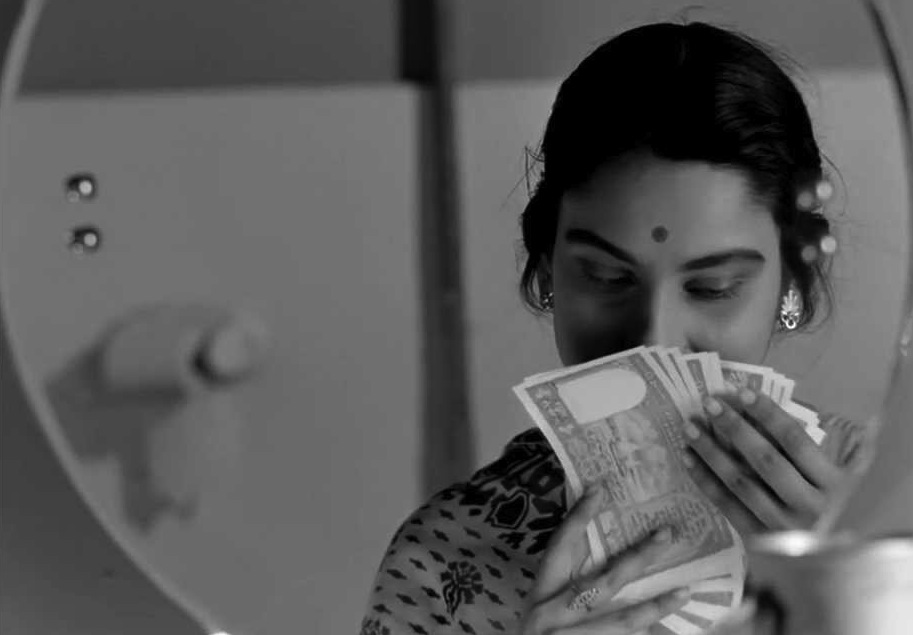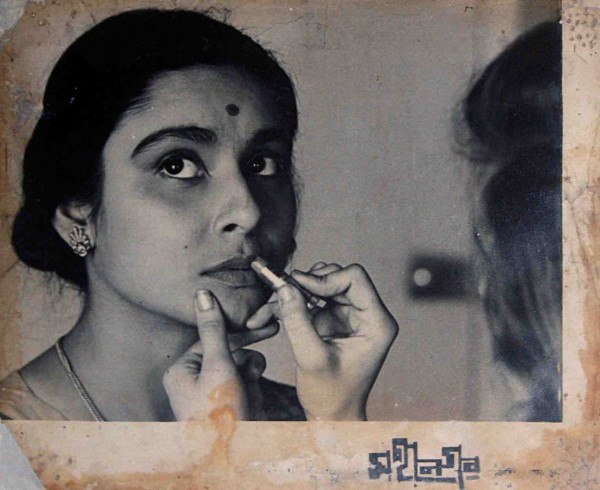Middle-class clerk Subrata Majumdar (Anil Chatterjee) pursuades his wife Arati (Madhabi Mukherjee) to take a job as a saleswoman as he with his meagre salary is unable to care for his large joint family consisting of his parents, unmarried sister Bani (Jaya Bhaduri) and son Pintu (Prasenjit Sarkar). The family is horrified at the thought of a working woman in their midst. For Arati, going door-to-door selling sewing machines opens up a whole new world which includes an Anglo-Indian friend, Edith (Vicky Redwood) and her employer Mukherjee (Haradhan Bannerjee). She proves to be quite successful in her work and gains self-confidence as she earns her own money. Earning money also changes Arati’s status within the family, causing further problems, more so when Subrata loses his job. He suffers as he watches his wife go out while he sits in bed and scans newspapers for job opportunities. They begin to grow apart. When Edith is unjustly sacked for racial reasons, Arati resigns in protest…
Mahanagar defines a marked departure in Satyajit Ray’s oeuvre. Before Mahanagar, his films were based either on literary classics, (Pather Panchali (1955), Aparajito (1956), Paras Pathar (1957), Jalsaghar (1958), Apur Sansar (1959), Devi (1960), Teen Kanya (1961)) or, on his own script (Kanchanjungha (1962)). Though Kanchanjungha dealt with the urban Bengali of Calcutta, the Roy Choudhurys came of affluent and aristocratic stock. With Mahanagar, Ray took his first step inside a low middle-class Bengali family home. As he once said, “somehow I feel that a common person, an ordinary person who you meet everyday on the street, is a more challenging subject for cinematic exploration than persons in heroic moulds, either good or bad. It is the half-shades, the hardly inaudible notes that I want to capture and explore.”
Mahanagar is based on a short story penned by Narendranath Mitra named Abataranika. The original story placed the husband at the centre but Ray shifted the emphasis to the wife, Arati. This change of focus re-wrote the history of women in Indian cinema. It traced the beginnings of the working wife in a lower middle-class family of Calcutta, her gradual autonomy in the face of economic pressures, and her changing status within the family by virtue of the change in her status quo in terms of employment. By going beyond the realms of the original, Ray changed the entire perspective of the story. Mahanagar is Ray’s personal statement on the changing values of the traditional, middle-class Bengali family of Calcutta. It is a microcosm of changes in urban, social values. Mahanagar is a strong, positive and realistic statement on the socio-economic changes in urban Bengali life, more through the metamorphosis of Arati than through other characters in the film. Arati stands as both the sign and the signified of this slow but steady socio-economic evolution.
The interiors of the Majumdar household reflect Ray’s genius for detail, detail that reaches beyond the borders of physical reality to underscore the emotional underpinnings in the relationships between and among the different members of the family. The clutter within the small flat, the sister-in-law drawing the tape that hangs the mosquito net, a slightly disturbed Subrata smoking inside the mosquito net, the close-up of Arati and her sister-in-law joking over the classifieds in the newspaper, the sister-in-law proudly scribbling Dada-Boudi in chalk on the kitchen floor as they lunch before stepping out, the sister-in-law shyly showing off the new saree Arati has bought for her with her salary, are a few examples.
The strong female bonding between a low-middle-class Bengali housewife and a low middle class Anglo-Indian spinster is perhaps, unique in Indian cinema. Ray establishes through the friendship between Arati and Edith, between Arati and her other female colleagues, the notion of ‘collectivity’ between and among women. This acquires and sustains greater power and strength only when established beyond the restrictive confines of ‘family.’ This very collectivity and female bonding, found subtle expression later, in Aranyer Din Ratri (1969) between the young girl (Sharmila Tagore) and her sister-in-law (Kaberi Bose) but was demystified when it came to blood-sisters in Seemabaddha (1971) and Kanchanjungha.
Despite surface differences, Arati and Edith are reduced to one entity, a working woman struggling to keep her family alive. The question of morals, whether linked to Arati’s clandestine use of lipstick, or to Edith’s so-called loose morals, has nothing to do with their efficiency at their jobs. The boss is a man in power, holding the financial futures of the women in his control. He abuses this power with Edith. Yet, he is over-generous with Arati. Ray’s handling of Edith’s humiliation and Arati’s angry response to the injustice meted out to Edith just because she is Anglo-Indian, is a telling comment on racism in reverse, the English-educated Bengali boss hitting it out at the dregs of British rule in India, the Anglo-Indian.
In Mahanagar, for the first time, Ray was dealing with an ordinary woman, who, one fine day, finds herself thrown out into the world, trying to make both ends meet for the extended family she belongs to. The family is sandwiched between the social hypocrisies of the low middle class and an impending financial crisis. Ray explores the metamorphosis of Arati, of Subrata – reeling under the emotional insecurities of a working wife, and in the relationships between and among the family members. He takes a wide sweep to cover an entire range of emotions, reactions and responses, of and to the concept of the slowly emergent working woman in urban India.
Three moving scenes demonstrate the slow change in Arati from a stay-at-home housewife to a working one. (a) When she gets her first pay packet, handed then in cold cash, she shows her money first to herself, in the bathroom mirror, her nostrils flared in excitement and in the pride of achievement. (b) She then shows it to her husband. (c) Then, in a crude gesture of grandiose generosity, she offers some to her father-in-law who needs a new pair of spectacles. Arati proves that a woman has vast resources of inner strength, which she is unaware of. She draws upon these resources when the time is right, when she discovers that patriarchy, which defines a society dominated by men, has failed to solve emerging socio-economic problems that have a bearing on the family to begin with, then on the economy, and finally, on the culture.
Mahanagar offers several readings of the text. It opens up possibilities of a Marxist reading of the film. It sheds light on the dual reproductive responsibilities of the woman who reproduces labour for the next generation (the little son who, in future will become an economically productive human being) and produces labour (through housework), for the current generation. Though her housework is comparatively marginalized, she still has some duties to perform. The third dimension that defines her is – she is the only financial contributor to the household expenses once she takes up the job. It also makes a feminist reading possible. Arati’s schism with Subrata is healed only when the two are at par, she too is jobless. Should one read between the lines to raise the question, would the chasm in the marriage have widened had Arati gone on with the job and had Subrata remained jobless? A sociological reading emerges from the Calcutta backdrop the narrative is set against. The tram car, the graffiti on the walls, the angry depositors at the bank, the interiors of the Majumdar’s home, the narrow and dingy lane in which they live, Edith’s home with its typically cluttered Anglo-Indian decor, Arati’s self-complacent and arrogant boss, the father-in-law’s snobbish pupil and his patronizing wife, the homes Arati visits to market her knitting machine, the barking Alsatian outside one of these homes, the gay camaraderie among the saleswomen, all point out to a richly textured collage of images in the backdrop, subtly reinforcing the message of a sociological transformation of the city and of its people.
The closing shot smoothens the fracture in the marriage brought in by Arati’s employed status vis-a-vis Subrata’s unemployed one. After giving her boss a piece of her mind, Arati walks out of the building to join Subrata. Both of them are now without jobs. As they walk and merge with the teeming crowds in the distance, the camera moves back to include a street light above. The film closes on this note of courage, their Calcutta will soon find them jobs, and hope, as long as they are together, fear and uncertainty are superfluous emotions.
Bengali, Drama, Black & White



